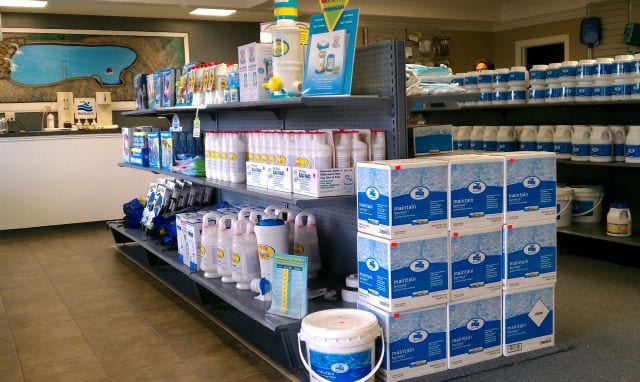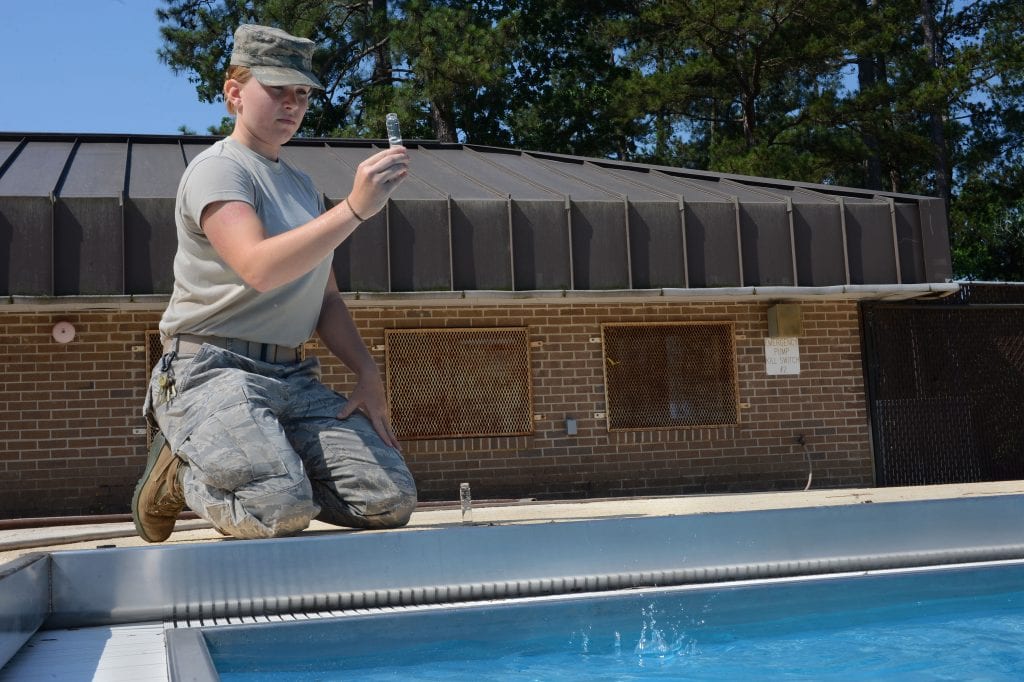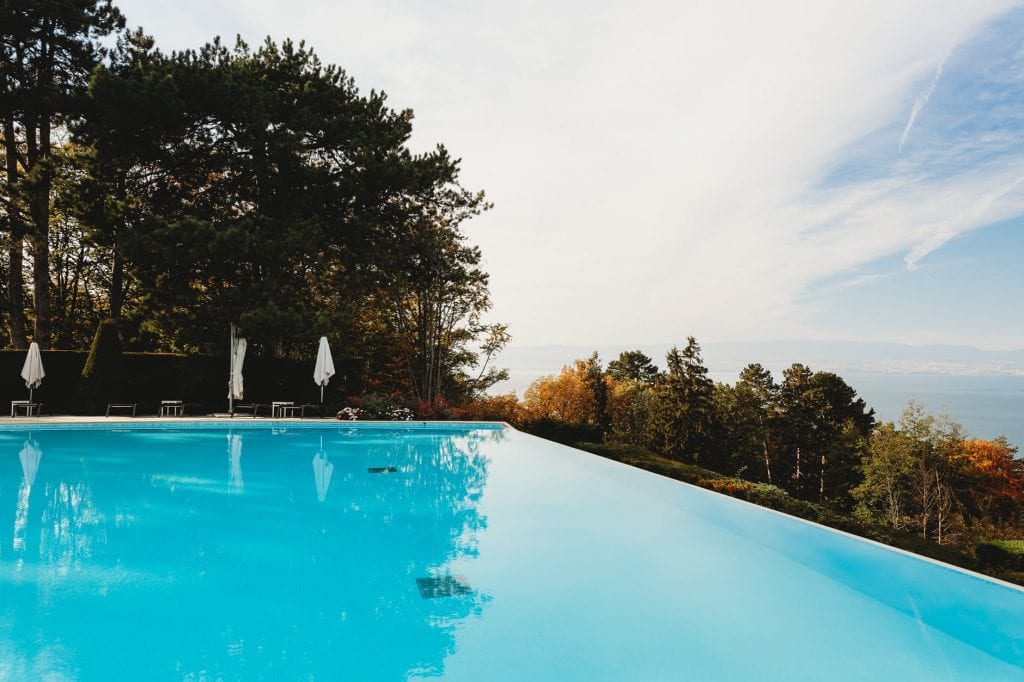United Chemical Easy Acid 1 Lb Alkalinity Decreaser
What order do you put chemicals in a pool?
Here's the correct order for adding pool chemicals:
-
- Total Alkalinity
- pH
- Calcium Hardness
- Sanitizer (chlorine)
- Cyanuric Acid (CYA)
And here's why it's a good idea to add pool chemicals in the above order:
- Total Alkalinity helps stabilize, and prevent fluctuations in pH. Adjusting TA first, makes adjusting pH easier later
- Calcium Hardness affects the physical "softness" of your water. And it's much easier to adjust when you first balance your pool
- A pH between 7.2 7.5 keeps your water feeling great, and your chlorine working effectively. But higher pH level reduce chlorine effectiveness half or more.
- CYA works as a direct stabilizer for chlorine, protecting it from sun damage and helping it last longer. Test your water before adding CYA to avoid chlorine lock, since most chlorine products already contain CYA
While you balance your water, you may think to yourself:
"Can you mix pool chemicals?"
And the answer to that question is: Never. Never mix pool chemicals.
It may sound like it'll save time, but it's dangerous, risky business. Certain chemical reactions can produce toxic fumes, and even cause small scale explosions. And that's not something any pool owner should ever deal with.
So for your health & safety, and everyone else's, never mix pool chemicals.
Always add pool chemicals one at a time. As explained earlier, this method is faster, and a lot more effective when done in the right order.
(Ready to start adding chemicals to your pool right now? Read this: Balance Your Pool Water In 7 Easy Steps)
So now that you know the correct order for adding pool chemicals, let's go over how much you'll need of each one.
What Pool Chemicals Do I Need, and How Much?

SANITIZERS
When it comes to sanitizing your pool water, you have a few different options:
Chlorine Tablets
Each 3-inch chlorine tablet can add up to 5 ppm of free chlorine per 10,000 gallons of water.
Directions: Use 2 chlorine tablets for every 10,000 gallons, per week
Example chlorine tablet dosages:
- 10,000 gallon pool
- 2 chlorine tablets per week
- 15,000 gallon pool
- 3 chlorine tablets per week
- 20,000 gallon pool
- 3-4 chlorine tablets per week
Pool Shock
A single 1 lb. bag of pool shock can increase your pool's free chlorine by 8-10 ppm, per 10,000 gallons.
Directions: Use 1 bag of pool shock for every 10,000 gallons of water, per week (or as needed)
Example pool shock dosages (1 pound bag):
- 10,000 gallon pool
- 1 bag per week
- 15,000 gallon pool
- 1-2 bags per week
- 20,000 gallon pool
- 2-3 bags per week
Biguanide
This is a non-chlorine, hydrogen peroxide based alternative to chlorine tablets. Although gentler on the skin, it can only be used with Baquacil pool chemicals, so it's not compatible with any of the other chemicals in this list.
Directions: Add enough biguanide to reach a sanitizer level of 30 – 50 ppm
Bromine
Bromine is another gentle alternative to chlorine. But unlike chlorine, it's not stabilized. This makes bromine best suited for indoor use, where sunlight won't burn it away.
Directions: Add enough bromine to reach a sanitizer level of 3 – 5 ppm
Salt (salt water pool)
If you own a salt water pool, this section is for you.
Two pounds of pool salt increases your salinity level by 1,000 ppm for every 10,000 gallons of water. The ideal pool salinity level is around 3200 ppm.
Directions: To increase your pool's salinity level from 0 to 3,200 ppm, use 6 bags/pounds of pool salt for every 10,000 gallons of water
Pool salt dosages:
- To increase salinity level by 500 ppm
- Use 1 pound of pool salt per 10,000 gallons
- To increase salinity level by 1,000 ppm
- Use 2 pounds of pool salt, per 10,000 gallons
WATER BALANCERS

Alkalinity Increaser (sodium bicarbonate)
One pound of sodium bicarbonate increases Total Alkalinity by 10 ppm, per every 10,000 gallons. And the ideal range for Total Alkalinity is 80 – 120 ppm.
Pro tip: You can also use baking soda, since it's essentially the same thing.
Directions: Use one pound of sodium bicarbonate for every 10,000 gallons of water to increase Total Alkalinity by 10 ppm.
Alkalinity Decreaser (dry acid)
If your Total Alkalinity levels are too high, you can lower them by using dry acid.
Directions: Use 2 pounds of dry acid per every 10,000 gallons to decrease TA by 10 ppm
pH Increaser (soda ash)
Good pH helps your chlorine work better, and last longer. It also affects how corrosive, neutral, or scale forming your water is.
As a reference point, for every 10,000 gallons of water, 6 ounces of sodium carbonate (soda ash) increases pH by .2. And ideal pH levels range from 7.2 to 7.6.
Directions: Use 6 ounces of soda ash for every 10,000 gallons of water to increase pH by .2
Using borax to increase pH
If you don't have any soda ash, you can add borax to your pool to increase the pH.
Directions: Add 20 ounces of borax for every 5,000 gallons of water to increase your pH by 0.5.
pH Decreaser
If your pH levels get too high, you can lower them by using sodium bisulfate, or muriatic acid.
Directions: Follow manufacturer dosage instructions
Calcium Hardness Increaser
Calcium hardness affects how "soft", or silky your water feels.
Ideal range for calcium hardness is between 200 – 400 ppm. Anything higher and you'll notice a difference in the texture of your water
Each 1 lb. of Calcium Hardness Increaser will raise hardness by 8 ppm, per 10000 gallons. 200-400 ppm is the recommended range.
Cyanuric Acid (Pool Stabilizer)
One pound of cyanuric acid will raise CYA levels by 12 ppm, per 10000 gallons. 30-50 ppm is the recommended range.
Have more questions about CYA? Get the answers here: How Cyanuric Acid Affects Your Pool's Chlorine
SPECIALTY CHEMICALS

Algaecide
Pool algaecide kills existing algae, and helps prevent new algae spores from spawning. But in order for it to work effectively, it has to be used correctly.
Algaecide works best when added after balancing your water.
Directions:
Initial Dosage: 12 oz. per 10000 gallons.
Maintenance Dosage: 3 oz. per 10000 gallons, weekly.
(Dealing with a green pool? Here's how to fix it)
Phosphate Remover
If you want to give your algaecide a boost, using a phosphate remover can help you do that. It's designed to help your filter remove phosphates lingering in the water, including the kind that algae feeds on.
Directions:
Initial Dosage: 5 oz. per 10000 gallons.
Maintenance Dosage: 5 oz. per 10000 gallons, weekly.
Pool Clarifier
Clarifiers work by clumping together the contaminants in your water, which makes them easier for your filter to catch.
Directions:
Initial Dosage: 4 oz. per 10000 gallons.
Maintenance Dosage: 2 oz. per 10000 gallons, weekly.
Pool Enzymes
Pool enzymes are what keep things like pink slime from forming in your pool. But they also work to fight off and remove organic stains.
Directions:
Initial Dosage: 5 oz. per 10000 gallons.
Maintenance Dosage: 5 oz. per 10000 gallons, weekly.
Stain & Scale Prevention
These chemicals do exactly what you would think. But most often, you need to buy each one separately.
You'll need stain remover for both organic and metal stains, as well as scale prevention to avoid calcium scaling..
Directions:
Follow manufacturer dosage instructions. Usually, each product will last at least 6 months
(Need to get rid of stains in your swimming pool? Check out this Pool Stain Removal Guide)
Closing thoughts: Which pool chemicals do you need, and how much
Here's a quick recap of which pool chemicals you need to run your pool, and how much:
- Chlorine Tablets
- How much: 2 tablets for every 10,000 gallons, per week
- Pool Shock
- How much: one pound for every 10,000 gallons of water, per week
- Alkalinity Increaser (sodium bicarbonate)
- How much: One pound for every 10,000 gallons to increase TA by 10 ppm
- Alkalinity Decreaser (dry acid)
- How much: 2 pounds for every 10,000 gallons to decrease TA by 10 ppm
- Calcium Hardness Increaser (calcium chloride)
- How much: One pound for every 10,000 gallons to increase Calcium Hardness by 8 ppm
- Cyanuric Acid
- How much: One pound for every 10,000 gallons to increase CYA by 12 ppm
- Pool Algaecide
- How much: 3 ounces for every 10,000 gallons per week
If you liked this post, you might also like:
Related posts:
Source: https://www.medallionenergy.com/pool-chemicals-guide/
0 Response to "United Chemical Easy Acid 1 Lb Alkalinity Decreaser"
Post a Comment